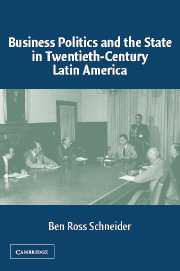Book contents
- Frontmatter
- Contents
- List of Tables
- List of Abbreviations
- Acknowledgments
- PART I INTRODUCTION AND ARGUMENTS
- PART II CASES AND COMPARISONS
- 3 From State to Societal Corporatism in Mexico
- 4 From Corporatism to Reorganized Disarticulation in Brazil
- 5 Business in Colombia: Well Organized and Well Connected
- 6 Consultation and Contention in the Making of Cooperative Capitalism in Chile
- 7 Business Politics in Argentina: Fragmented and Politicized
- PART III IMPLICATIONS AND CONCLUSIONS
- Appendix A Background Information on Major Business Associations
- Appendix B Interviews
- Appendix C Conversions
- References
- Index
6 - Consultation and Contention in the Making of Cooperative Capitalism in Chile
Published online by Cambridge University Press: 23 November 2009
- Frontmatter
- Contents
- List of Tables
- List of Abbreviations
- Acknowledgments
- PART I INTRODUCTION AND ARGUMENTS
- PART II CASES AND COMPARISONS
- 3 From State to Societal Corporatism in Mexico
- 4 From Corporatism to Reorganized Disarticulation in Brazil
- 5 Business in Colombia: Well Organized and Well Connected
- 6 Consultation and Contention in the Making of Cooperative Capitalism in Chile
- 7 Business Politics in Argentina: Fragmented and Politicized
- PART III IMPLICATIONS AND CONCLUSIONS
- Appendix A Background Information on Major Business Associations
- Appendix B Interviews
- Appendix C Conversions
- References
- Index
Summary
Today we are strong because we are organized, tomorrow we will be invincible because we will have improved our organization.
President of the National Agricultural Society, 1934Introduction
The Industry Building or Edificio de la Industria is a gleaming high rise in a prime area of Santiago's new business district. Sofofa (Sociedad de Fomento Fabril), the long-standing industry association, constructed the Edificio de la Industria in the 1990s in order to move out of its old quarters in the declining city center. Sofofa occupies the first three stories of the building, and made a lot of money selling space on the floors above. Similar stories of wealth, modernization, and institutional strength could be told about other peak sectoral associations in mining, construction, and agriculture, as well as for the economy-wide peak association, the CPC (Confederación de la Producción y del Comercio). In organizational terms, business in Chile ranks on the high end of the continuum of strong encompassing associations along with Mexico and Colombia.
The similarities and contrasts among these three countries are revealing. As in Colombia, Chilean business organized voluntary associations with significant institutional capacity that derived strength from their institutionalized access to policy making. Business elites also frequently circulated through top policy positions in government, though this circulation was more variable and ended with the return to civilian rule in 1990. Beyond these broad similarities, the contrasts with Colombia are significant.
- Type
- Chapter
- Information
- Publisher: Cambridge University PressPrint publication year: 2004
- 1
- Cited by



